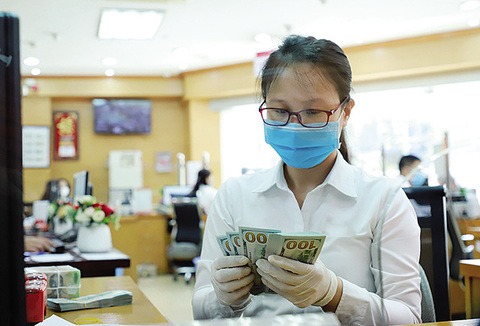Fintech has great potential for growth in Vietnam
Fintech has great potential for growth in Vietnam
Financial Technology (Fintech) is made up of five types of financial services. First is the digital payment method, second includes deposits, loans, and capital mobilization, third covers insurance, and the fourth deals with investment management. The fifth type basically only deals with market support. In this, the first two types have great financial potential, especially in developing countries like Vietnam.
Illustrative photo. |
Development trends
In the ASEAN countries, one of the indicators of financial inclusion for individuals is the percentage of the population aged 15 years and above, who have an account with a legitimate financial institution, which could be a bank or any other financial channel. Statistics from the global Findex Index survey conducted by the World Bank (WB) for the period 2014 until 2017, shows an increasing trend over the years. The most interesting point is that there is a clear separation between the group of high-income countries such as Singapore, with a rate of 90%, and other countries such as Malaysia and Thailand at 80% to 90%; and some middle-income countries at 15% to 50%, such as Cambodia, Indonesia, Myanmar, Philippines, and Vietnam.
However, the participation of micro, small and medium enterprises (MSMEs) in the capital market that connect with Fintech is still limited. Data from the Asian Development Bank (ADB) shows that the stock market capitalization of MSMEs in 2019 was about 14.8% of GDP in Vietnam, followed by Laos at 5.9%, Cambodia at 2.6%, Singapore at 1.9%, Malaysia at 1.4%, Thailand at 1.3%, and the Philippines at 0.1%. However, the development of the MSME bond market in the region is still in its early stage. The current development trend shows that Fintech not only affects banking operations through competitiveness but also affects the application of new ways to develop products, access deeper markets, in addition to corresponding risk identification and assessment.
On the whole, Fintech is spreading rapidly among higher-income countries in the ASEAN region, but the contribution of alternative finance methods remains modest. No country in this region has an alternative lending ratio greater than 0.1% of GDP. Therefore, the path to creating impact at the macro level is still very small, so it is still not a serious threat to traditional banks.
Nowhere has the Fintech sector grown faster and transformed a country like in China. When China got its first starting point in 2004, Fintech quickly changed the Chinese system from an outdated, cash-based financial system to a global leader in Fintech. The experience from China in Fintech is perhaps a learning lesson for many countries that are strategically modernizing their financial services in an evasive way.
Changes in China have occurred rapidly throughout the financial industry on an unprecedented scale. It is the China Banking Regulatory Commission (CBRC) that has carried out digital banking licensing to expand more private owned banks, which have brought fair competition to the banking sector, in both private and public spheres. The first digital bank, WeBank was established in 2014, and the second bank, MyBank, was licensed in 2015. Since 2015, Ant Financial, a financial services company spun off from Alibaba, has used big data to manage credit risk, launching small businesses and consumer lending products.
Fintech in China now covers almost every sector of the financial industry, from payments to lending, and insurance to investment. The most successful are mobile payments and Big Tech credit. Currently, there are about 1 billion people who regularly use Alipay and Tenpay. Since 2017, both Alipay and Tenpay have implemented QR code payment systems. A study assessing the impact of the Covid-19 pandemic on small businesses found that approximately 97.8 million offline stores and vendors use QR code payment systems.
Development policy
In general, policymakers in ASEAN countries have shown a willingness to support and create policies for Fintech to develop in a robust way. However, there is still a certain amount of caution due to limited understanding and ability to manage risks. Hence for the purpose of just wanting to quickly upgrade a financial system, then China provides the best lessons. Firstly, there is flexibility in mechanisms and policies which is very important in the first phase of financial inclusion, which allows testing of Fintech products and models.
Secondly, the issue of pioneering policy creation and pioneering pilot implementation can lead to risks for policy makers, individuals, and participating organizations. Therefore, it is necessary to create an experimental space and allow implementation through legislation. Thirdly, the responsibility to manage, regulate and supervise a new market like Fintech must be clearly demarcated from the outset. Fourthly, large technology companies are the best candidates to pioneer the adoption of Fintech models, but supervision is needed to intervene and ensure fair competition for traditional entities that have not yet converted to new trends, which creates a distinct advantage to dominate and distort the market. China now knows how to deal with new digital financial products and services after learning from tech giants, to create a healthy development of the digital financial industry.
Suggestions for Vietnam
First and foremost, it is imperative to create an effective policy and loosen restraints on the trend of Fintech development associated with financial inclusion. At this time, a pilot plan for technology companies will help the regulator understand how it works and avoid possible risks for products and models from Fintech in particular and a comprehensive financial strategy in general.
Second, it is essential to maintain policy flexibility combined with management capabilities commensurate with the size and complexity of new models and products in the Fintech sector. Typically, technology companies must have a separate monitoring mechanism. When new products are launched on the market, they must be approved by the regulatory agency. In addition to maintaining financial market stability and protecting investors and consumers, it is necessary to avoid apprehension, lack of responsibility, and strict regulations that hinder development.
Third, it is extremely important to have a clear legal framework and stance on expanding control and access by third parties, rather than just letting technology companies hold data. Currently, China is putting data control into the hands of the State and state-owned companies, not allowing big technology companies to manipulate.
Fourth, the level of development of Fintech and Fintech regulations varies greatly between countries and regions. Therefore, it is necessary to establish the Association of Fintech businesses to represent the voice of businesses and set up a separate Fintech monitoring and support agency within the Government to balance creating a favorable business environment for new experiments, while protecting consumers.
Fifth, it is necessary to immediately issue a legal framework as well as an infrastructure foundation for DLT and digital assets. The fact that China has also accepted digital assets such as non-fungible tokens (NFT), and the fact that countries have accepted digital assets, including NFT assets developed on cryptocurrency platforms, provides enough hints. The recognition of digital assets is a premise for some countries such as the U.K., the US, and the EU to collect taxes on cryptocurrency and NFT asset trading activities, which has contributed to generating tax revenue with significant digital assets while creating a legal corridor for companies to develop applications for a crypto-asset economy.





















